雅思阅读9分之List_of_Headings题
【参考文档】雅思阅读List of Headings题型解题技巧 -范文模板 (1页)
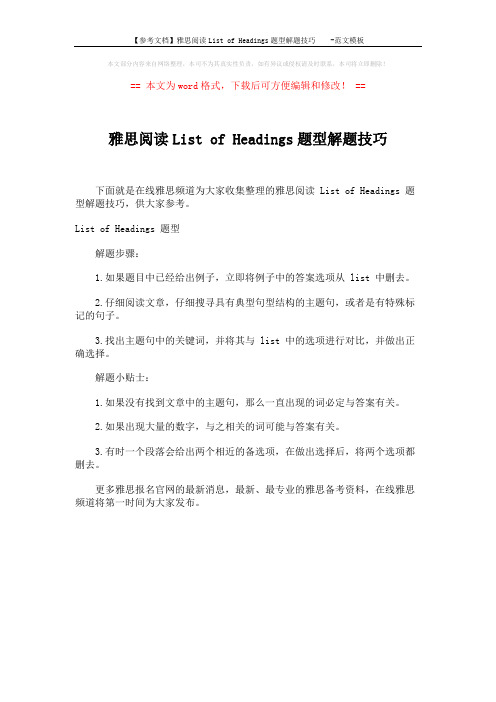
【参考文档】雅思阅读List of Headings题型解题技巧-范文模板本文部分内容来自网络整理,本司不为其真实性负责,如有异议或侵权请及时联系,本司将立即删除!
== 本文为word格式,下载后可方便编辑和修改! ==
雅思阅读List of Headings题型解题技巧
下面就是在线雅思频道为大家收集整理的雅思阅读 List of Headings 题型解题技巧,供大家参考。
List of Headings 题型
解题步骤:
1.如果题目中已经给出例子,立即将例子中的答案选项从 list 中删去。
2.仔细阅读文章,仔细搜寻具有典型句型结构的主题句,或者是有特殊标记的句子。
3.找出主题句中的关键词,并将其与 list 中的选项进行对比,并做出正确选择。
解题小贴士:
1.如果没有找到文章中的主题句,那么一直出现的词必定与答案有关。
2.如果出现大量的数字,与之相关的词可能与答案有关。
3.有时一个段落会给出两个相近的备选项,在做出选择后,将两个选项都删去。
更多雅思报名官网的最新消息,最新、最专业的雅思备考资料,在线雅思频道将第一时间为大家发布。
雅思3.3 List of Headings

解题注意事项
(1) 如果主题句是复合句,应重点看主句部分 (2) 如果主题句中有show ,suggest,argue, believe,doubt,assert 等表明观点的词,应重 点看其后的宾语从句。 (3) 如果主题句是not only…, but also…句型, 应重点看but also 后面的部分。 (4)多注意but,yet,however,so, thus后面 的部分 (5) 多注意冒号和分号后面的内容,真正的主题 句可能在它们后面 (6)问句通常不会是主题句
解题步骤
◆ 浏览的同时划出所有选项的关键词 (1) 围绕主概念的词,划出实义名词; (2) 对于多次出现的主概念词或实义名词, 也划上其修饰词,并注意区别; (3) 对相似的选项(twins选项)进行归类和 对比; (4) 注意上升下降的趋势词和正负态度及褒 贬词
解题步骤
3.阅读原文,读每段话时,抓住这段话的 主题句和核心词汇,寻找同义词,正确答 案往往是主题句的改写。
快速解题技巧
题中
future past statistics / demographics salary funding financial economics business pension 养老金 subsidy 津贴
文中
2046 1984 40% 400$
C7T3P2 P69
List of Headings
解题步骤
1.在题目和段落中划去例题,避免误选。 同时不读例子所在的段落,节约时间。 2.浏览剩下的headings,对题目做初步了解。 不要看一个标题就去找对应的段落,一定要记 住关键词再看段落。 ◆ 浏览时将不符合文章主题的heading直接排 除 具有下列特征的headings一般不大可能是正确的: (1)带有some一词的选项 (2)与其它选项相比,过于具体的选项 (3)突显价格之昂贵等过于极端的选项
剑桥雅思阅读9(test1)原文答案解析
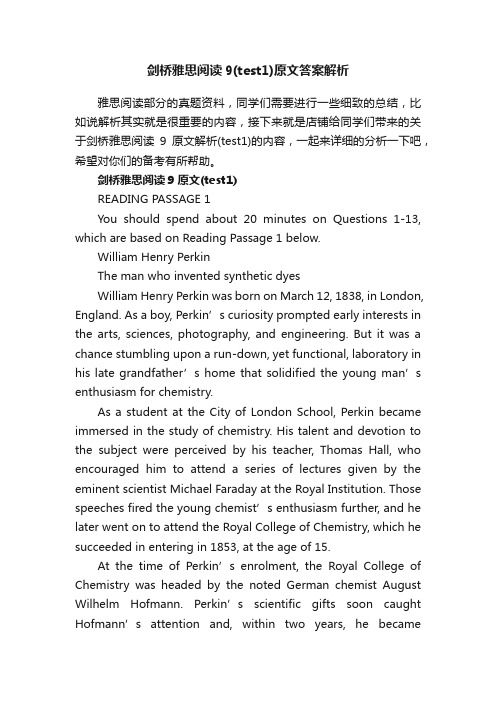
剑桥雅思阅读9(test1)原文答案解析雅思阅读部分的真题资料,同学们需要进行一些细致的总结,比如说解析其实就是很重要的内容,接下来就是店铺给同学们带来的关于剑桥雅思阅读9原文解析(test1)的内容,一起来详细的分析一下吧,希望对你们的备考有所帮助。
剑桥雅思阅读9原文(test1)READING PASSAGE 1You should spend about 20 minutes on Questions 1-13, which are based on Reading Passage 1 below.William Henry PerkinThe man who invented synthetic dyesWilliam Henry Perkin was born on March 12, 1838, in London, England. As a boy, Perkin’s curiosity prompted early intere sts in the arts, sciences, photography, and engineering. But it was a chance stumbling upon a run-down, yet functional, laboratory in his late grandfather’s home that solidified the young man’s enthusiasm for chemistry.As a student at the City of London School, Perkin became immersed in the study of chemistry. His talent and devotion to the subject were perceived by his teacher, Thomas Hall, who encouraged him to attend a series of lectures given by the eminent scientist Michael Faraday at the Royal Institution. Those speeches fired the young chemist’s enthusiasm further, and he later went on to attend the Royal College of Chemistry, which he succeeded in entering in 1853, at the age of 15.At the time of Perkin’s enrolment, the Royal College of Chemistry was headed by the noted German chemist August Wilhelm Hofmann. Perkin’s scientific gifts soon caught Hofmann’s attention and, within two years, he becameHofmann’s youngest assistant. Not long after that, Perkin made the scientific breakthrough that would bring him both fame and fortune.At the time, quinine was the only viable medical treatment for malaria. The drug is derived from the bark of the cinchona tree, native to South America, and by 1856 demand for the drug was surpassing the available supply. Thus, when Hofmann made some passing comments about the desirability of a synthetic substitute for quinine, it was unsurprising that his star pupil was moved to take up the challenge.During his vacation in 1856, Perkin spent his time in the laboratory on th e top floor of his family’s house. He was attempting to manufacture quinine from aniline, an inexpensive and readily available coal tar waste product. Despite his best efforts, however, he did not end up with quinine. Instead, he produced a mysterious dark sludge. Luckily, Perkin’s scientific training and nature prompted him to investigate the substance further. Incorporating potassium dichromate and alcohol into the aniline at various stages of the experimental process, he finally produced a deep purple solution. And, proving the truth of the famous scientist Louis Pasteur’s words ‘chance favours only the prepared mind’, Perkin saw the potential of his unexpected find.Historically, textile dyes were made from such natural sources as plants and animal excretions. Some of these, such as the glandular mucus of snails, were difficult to obtain and outrageously expensive. Indeed, the purple colour extracted from a snail was once so costly in society at the time only the rich could afford it. Further, natural dyes tended to be muddy in hue and fade quickly. It was against this backdrop that Perkin’sdiscovery was made.Perkin quickly grasped that his purple solution could be used to colour fabric, thus making it the world’s first synthetic dye. Realising the importance of this breakthrough, he lost no time in patenting it. But perhaps the most fascinating of all Perkin’s reactions to his find was his nearly instant recognition that the new dye had commercial possibilities.Perkin originally named his dye Tyrian Purple, but it later became commonly known as mauve (from the French for the plant used to make the colour violet). He asked advice of Scottish dye works owner Robert Pullar, who assured him that manufacturing the dye would be well worth it if the colour remained fast (i.e. would not fade) and the cost was relatively low. So, over the fierce objections of his mentor Hofmann, he left college to give birth to the modern chemical industry.With the help of his father and brother, Perkin set up a factory not far from London. Utilising the cheap and plentiful coal tar that was an almost unlimited byproduct of London’s gas street lighting, the dye works began producing the world’s first synthetically dyed material in 1857. The company received a commercial boost from the Empress Eugenie of France, when she decided the new colour flattered her. Very soon, mauve was the necessary shade for all the fashionable ladies in that country. Not to be outdone, England’s Queen Victoria also appeared in public wearing a mauve gown, thus making it all the rage in England as well. The dye was bold and fast, and the public clamoured for more. Perkin went back to the drawing board.Although Perkin’s fame was achieved and fortune assured by his first discovery, the chemist continued his research. Among other dyes he developed and introduced were aniline red (1859)and aniline black (1863) and, in the late 1860s, Perkin’s green. It is important to note that Perkin’s synthetic dye discoveries had outcomes far beyond the merely decorative. The dyes also became vital to medical research in many ways. For instance, they were used to stain previously invisible microbes and bacteria, allowing researchers to identify such bacilli as tuberculosis, cholera, and anthrax. Artificial dyes continue to play a crucial role today. And, in what would have been particularly pleasing to Perkin, their current use is in the search for a vaccine against malaria.Questions 1-7Do the following statements agree with the information given in Reading Passage 1?In boxes 1-7 on your answer sheet, writeTRUE if the statement agrees with the informationFALSE if the statement contradicts the informationNOT GIVEN if there is no information on this1 Michael Faraday was the first person to recognise Perkin’s ability as a student of chemistry.2 Michael Faraday suggested Perkin should enrol in the Royal College of Chemistry.3 Perkin employed August Wilhelm Hofmann as his assistant.4 Perkin was still young when he made the discovery that made him rich and famous.5 The trees from which quinine is derived grow only in South America.6 Perkin hoped to manufacture a drug from a coal tar waste product.7 Perkin was inspired by the discoveries of the famous scientist Louis Pasteur.Questions 8-13Answer the questions below.Choose NO MORE THAN TWO WORDS from the passage for each answer.Write your answers in boxes 8-13 on your answer sheet.8 Before Perkin’s discovery, with what group in society was the colour purple associated?9 What potential did Perkin immediately understand that his new dye had?10 What was the name finally used to refer to the first colour Perkin invented?11 What was the name of the person Perkin consulted before setting up his own dye works?12 In what country did Perkin’s newly invented colour first become fashionable?13 According to the passage, which disease is now being targeted by researchers using synthetic dyes?READING PASSAGE 2You should spend about 20 minutes on Questions 14-26, which are based on Reading Passage 2 on the following pages.Questions 14-17Reading Passage 2 has five paragraphs, A-E.Choose the correct heading for paragraphs B-E from the list of headings below.Write the correct number, i-vii, in boxes 14-17 on your answer sheet.List of Headingsi Seeking the transmission of radio signals from planetsii Appropriate responses to signals from other civilisations iii Vast distances to Earth’s closest neighboursiv Assumptions underlying the search for extra-terrestrial intelligencev Reasons for the search for extra-terrestrial intelligencevi Knowledge of extra-terrestrial life formsvii Likelihood of life on other planetsExample AnswerParagraph A v14 Paragraph B15 Paragraph C16 Paragraph D17 Paragraph EIS THERE ANYBODY OUT THERE?The Search for Extra-terrestrial IntelligenceThe question of whether we are alone in the Universe has haunted humanity for centuries, but we may now stand poised on the brink of the answer to that question, as we search for radio signals from other intelligent civilisations. This search, often known by the acronym SETI (search for extra-terrestrial intelligence), is a difficult one. Although groups around the world have been searching intermittently for three decades, it is only now that we have reached the level of technology where we can make a determined attempt to search all nearby stars for any sign of life.AThe primary reason for the search is basic curiosity hethe same curiosity about the natural world that drives all pure science. We want to know whether we are alone in the Universe. We want to know whether life evolves naturally if given the right conditions, or whether there is something very special about the Earth to have fostered the variety of life forms that, we seearound us on the planet. The simple detection of a radio signal will be sufficient to answer this most basic of all questions. In this sense, SETI is another cog in the machinery of pure science which is continually pushing out the horizon of our knowledge. However, there are other reasons for being interested in whether life exists elsewhere. For example, we have had civilisation on Earth for perhaps only a few thousand years, and the threats of nuclear war and pollution over the last few decades have told us that our survival may be tenuous. Will we last another two thousand years or will we wipe ourselves out? Since the lifetime of a planet like ours is several billion years, we can expect that, if other civilisations do survive in our galaxy, their ages will range from zero to several billion years. Thus any other civilisation that we hear from is likely to be far older, on average, than ourselves. The mere existence of such a civilisation will tell us that long-term survival is possible, and gives us some cause for optimism. It is even possible that the older civilisation may pass on the benefits of their experience in dealing with threats to survival such as nuclear war and global pollution, and other threats that we haven’t yet discovered.BIn discussing whether we are alone, most SETI scientists adopt two ground rules. First, UFOs (Unidentified Flying Objects) are generally ignored since most scientists don’t consider the evidence for them to be strong enough to bear serious consideration (although it is also important to keep an open mind in case any really convincing evidence emerges in the future). Second, we make a very conservative assumption that we are looking for a life form that is pretty well like us, since if it differs radically from us we may well not recognise it as a life form,quite apart from whether we are able to communicate with it. In other words, the life form we are looking for may well have two green heads and seven fingers, but it will nevertheless resemble us in that it should communicate with its fellows, be interested in the Universe, live on a planet orbiting a star like our Sun, and perhaps most restrictively, have a chemistry, like us, based on carbon and water.CEven when we make these assumptions, our understanding of other life forms is still severely limited. We do not even know, for example, how many stars have planets, and we certainly do not know how likely it is that life will arise naturally, given the right conditions. However, when we look at the 100 billion stars in our galaxy (the Milky Way), and 100 billion galaxies in the observable Universe, it seems inconceivable that at least one of these planets does not have a life form on it; in fact, the best educated guess we can make, using the little that we do know about the conditions for carbon-based life, leads us to estimate that perhaps one in 100,000 stars might have a life-bearing planet orbiting it. That means that our nearest neighbours are perhaps 100 light years away, which is almost next door in astronomical terms.DAn alien civilistation could choose many different ways of sending information across the galaxy, but many of these either require too much energy, or else are severely attenuated while traversing the vast distances across the galaxy. It turns out that, for a given amount of transmitted power, radio waves in the frequency range 1000 to 3000 MHz travel the greatest distance, and so all searches to date have concentrated on looking forradio waves in this frequency range. So far there have been a number of searches by various groups around the world, including Australian searches using the radio telescope at Parkes, New South Wales. Until now there have not been any detections from the few hundred stars which have been searched. The scale of the searches has been increased dramatically since 1992, when the US Congress voted NASA $10 million per year for ten years to conduct, a thorough search for extra-terrestrial life. Much of the money in this project is being spent on developing the special hardware needed to search many frequencies at once. The project has two parts. One part is a targeted search using the world’s largest radio telescopes, the American-operated telescope in Arecibo, Puerto Rico and the French telescope in Nancy in France. This part of the project is searching the nearest 1000 likely stars with high sensitivity for signals in the frequency rang 1000 to 3000 MHz. The other part of the project is an undirected search which is monitoring all of space with a lower sensitivity, using the smaller antennas of NASA’s Deep Space Network.EThere is considerable debate over how we should react if we detect a signal from an alien civilisation. Everybody agrees that we should not reply immediately. Quite apart from the impracticality of sending a reply over such large distances at short notice, it raises a host of ethical questions that would have to be addressed by the global community before any reply could be sent. Would the human race face the culture shock if faced with a superior and much older civilisation? Luckily, there is no urgency about this. The stars being searched are hundreds of light years away, so it takes hundreds of years for their signal toreach us, and a further few hundred years for our reply to reach them. It’s not important, then, if there’s a delay of a few years, or decades, while the human race debates the question of whether to reply, and perhaps carefully drafts a reply.Questions 18-20Answer the questions below.Choose NO MORE THAN THREE WORDS AND/OR A NUMBER from the passage for each answer.Write your answers in boxes 18-20 on your answer sheet.18 What is the life expectancy of Earth?19 What kind of signals from other intelligent civilisations are SETI scientists searching for?20 How many stars are the world’s most powerful radio telescopes searching?Questions 21-26Do the following statements agree with the views of the writer in Reading Passage 2?In boxes 21-26 on your answer sheet, writeYES if the statement agrees with the views of the writerNO if the statement contradicts the views of the writerNOT GIVEN if it is impossible to say what the writer thinks about this21 Alien civilisations may be able to help the human race to overcome serious problems.22 SETI scientists are trying to find a life form that resembles humans in many ways.23 The Americans and Australians have co-operated on joint research projects.24 So far SETI scientists have picked up radio signals from several stars.25 The NASA project attracted criticism from some members of Congress.26 If a signal from outer space is received, it will be important to respond promptly.READING PASSAGE 3You should spend about 20 minutes on Questions 27-40, which are based on Reading Passage 3 below.The history of the tortoiseIf you go back far enough, everything lived in the sea. At various points in evolutionary history, enterprising individuals within many different animal groups moved out onto the land, sometimes even to the most parched deserts, taking their own private seawater with them in blood and cellular fluids. In addition to the reptiles, birds, mammals and insects which we see all around us, other groups that have succeeded out of water include scorpions, snails, crustaceans such as woodlice and land crabs, millipedes and centipedes, spiders and various worms. And we mustn’t forget the pla nts, without whose prior invasion of the land none of the other migrations could have happened.Moving from water to land involved a major redesign of every aspect of life, including breathing and reproduction. Nevertheless, a good number of thorough going land animals later turned around, abandoned their hard-earned terrestrial re-tooling, and returned to the water again. Seals have only gone part way back. They show us what the intermediates might have been like, on the way to extreme cases such as whales and dugongs. Whales (including the small whales we call dolphins) and dugongs, with their close cousins the manatees, ceased to be land creatures altogether and reverted to the full marine habits of their remote ancestors. They don’t even come ashoreto breed. They do, however, still breathe air, having never developed anything equivalent to the gills of their earlier marine incarnation. Turtles went back to the sea a very long time ago and, like all vertebrate returnees to the water, they breathe air. However, they are, in one respect, less fully given back to the water than whales or dugongs, for turtles still lay their eggs on beaches.There is evidence that all modern turtles are descended from a terrestrial ancestor which lived before most of the dinosaurs. There are two key fossils called Proganochelys quenstedti and Plaeochersis talampayensis dating from early dinosaur times, which appear to be close to the ancestry of all modern turtles and tortoises. You might wonder how we can tell whether fossil animals lived on land or in water, especially if only fragments are found. Sometimes it’s obvious. Ichthyosaurs were reptilian contemporaries of the dinosaurs, with fins and streamlined bodies. The fossils look like dolphins and they surely lived like dolphins, in the water. With turtles it is a little less obvious. One way to tell is by measuring the bones of their forelimbs.Walter Joyce and Jacques Gauthier, at Yale University, obtained three measurements in these particular bones of 71 species of living turtles and tortoises. They used a kind of triangular graph paper to plot the three measurements against one another. All the land tortoise species formed a tight cluster of points in the upper part of the triangle; all the water turtles cluster in the lower part of the triangular graph. There was no overlap, except when they added some species that spend time both in water and on land. Sure enough, these amphibious species show up on the triangular graph approximately half way between the ‘wet cluster’ of sea turtles and the ‘dry cluster’of land tortoises. The next step was to determine where the fossils fell. The bones of P. quenstedti and P. talampayensis leave us in no doubt. Their points on the graph are right in the thick of the dry cluster. Both these fossils were dry-land tortoises. They come from the era before our turtles returned to the water.You might think, therefore, that modern land tortoises have probably stayed on land ever since those early terrestrial times, as most mammals did after a few of them went back to the sea. But apparently not. If you draw out the family three of all modern turtles and tortoises, nearly all the branches are aquatic. Today’s land tortoises constitute a single branch, deeply nested among branches consisting of aquatic turtles. This suggests that modern land tortoises have not stayed on land continuously since the time of P. quenstedti and P. talampayensis. Rather, their ancestors were among those who went back to the water, and they then reemerged back onto the land in (relatively) more recent times.Tortoises therefore represent a remarkable double return. In common with all mammals, reptiles and birds, their remote ancestors were marine fish and before that various more or less worm-like creatures stretching back, still in the sea, to the primeval bacteria. Later ancestors lived on land and stayed there for a very large number of generations. Later ancestors still evolved back into the water and became sea turtles. And finally they returned yet again to the land as tortoises, some of which now live in the driest of deserts.Questions 27-30Answer the questions below.Choose NO MORE THAN TWO WORDS from the passage for each answer.Write your answers in boxes 27-30 on your answer sheet.27 What had to transfer from sea to land before any animals could migrate?28 Which TWO processes are mentioned as those in which animals had to make big changes as they moved onto lands?29 Which physical feature, possessed by their ancestors, do whales lack?30 which animals might ichthyosaurs have resembled?Questions 31-33Do the following statements agree with the information given in Reading Passage 3?In boxes 31-33 on your answer sheet, writeTRUE if the statement agrees with the informationFALSE if the statement contradicts the informationNOT GIVEN if there is no information on this31 Turtles were among the first group of animals to migrate back to the sea.32 It is always difficult to determine where an animal lived when its fossilised remains are incomplete.33 The habitat of ichthyosaurs can be determined by the appearance of their fossilised remains.Questions 34-39Complete the flow-chart below.Choose NO MORE THAN TWO WORDS AND/OR A NUMBER from the passage for each answer.Write your answers in boxes 34-39 on your answer sheet.Method of determining where the ancestors of turtles and tortoises come fromStep 171 species of living turtles and tortoises were examined anda total of 34 ……………………. were taken from the bones of theirforelimbs.Step 2The data was recorded on a 35 ……………….. (necessary for comparing the information).Outcome: Land tortoises were represented by a dense 36 …………………………… of points towards the top.Sea turtles were grouped together in the bottom part.Step 3The same data was collected from some living 37 ………………. species and added to the other results.Outcome: The points for these species turned out to be positioned about 38 ……………… up the triangle between the land tortoises and the sea turtles.Step 4Bones of P. quenstedti and P. talampayensis were examined in a similar way and the results added.Outcome: The position of the points indicated that both these ancient creatures were 39…………..Question 40Choose the correct letter, A, B, C or D.Write the correct letter in box 40 on your answer sheet.According to the writer, the most significant thing about tortoises is thatA they are able to adapt to life in extremely dry environments.B their original life form was a kind of primeval bacteria.C they have so much in common with sea turtles.D they have made the transition from sea to land more than once.剑桥雅思阅读9原文参考译文(test1)PASSAGE 1参考译文:William Henry Perkin 合成染料的发明者Wiliam Henry Perkin于1838年3月12日出生于英国伦敦。
雅思阅读List-of-heading策略------常见反向思维词归纳
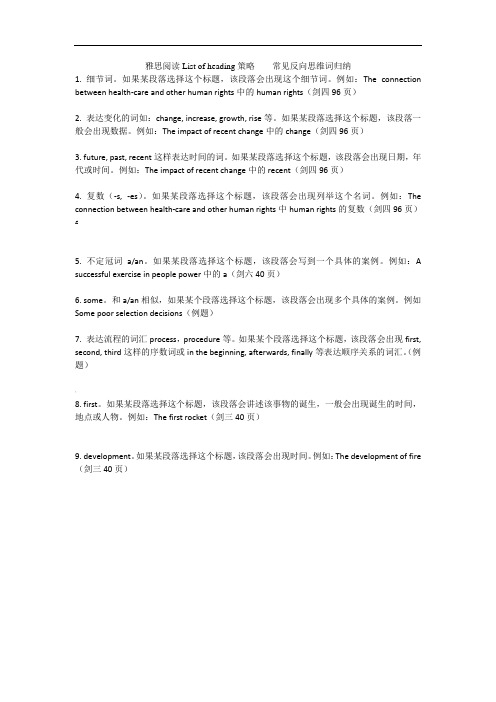
雅思阅读List of heading策略------常见反向思维词归纳1. 细节词。
如果某段落选择这个标题,该段落会出现这个细节词。
例如:The connection between health-care and other human rights中的human rights(剑四96页)2. 表达变化的词如:change, increase, growth, rise等。
如果某段落选择这个标题,该段落一般会出现数据。
例如:The impact of recent change中的change(剑四96页)3. future, past, recent这样表达时间的词。
如果某段落选择这个标题,该段落会出现日期,年代或时间。
例如:The impact of recent change中的recent(剑四96页)4. 复数(-s, -es)。
如果某段落选择这个标题,该段落会出现列举这个名词。
例如:The connection between health-care and other human rights中human rights的复数(剑四96页)&5. 不定冠词a/an。
如果某段落选择这个标题,该段落会写到一个具体的案例。
例如:A successful exercise in people power中的a(剑六40页)6. some。
和a/an相似,如果某个段落选择这个标题,该段落会出现多个具体的案例。
例如Some poor selection decisions(例题)7. 表达流程的词汇process,procedure等。
如果某个段落选择这个标题,该段落会出现first, second, third这样的序数词或in the beginning, afterwards, finally等表达顺序关系的词汇。
(例题)-8. first。
如果某段落选择这个标题,该段落会讲述该事物的诞生,一般会出现诞生的时间,地点或人物。
雅思阅读Listofheadings题型解题技巧详解
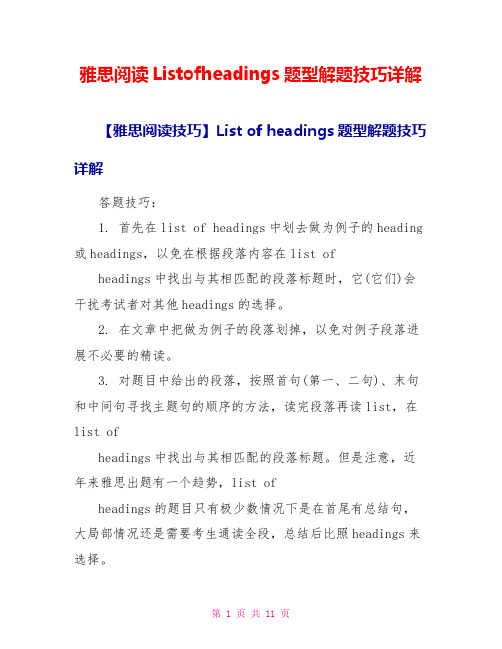
雅思阅读Listofheadings题型解题技巧详解【雅思阅读技巧】List of headings题型解题技巧详解答题技巧:1. 首先在list of headings中划去做为例子的heading 或headings,以免在根据段落内容在list ofheadings中找出与其相匹配的段落标题时,它(它们)会干扰考试者对其他headings的选择。
2. 在文章中把做为例子的段落划掉,以免对例子段落进展不必要的精读。
3. 对题目中给出的段落,按照首句(第一、二句)、末句和中间句寻找主题句的顺序的方法,读完段落再读list,在list ofheadings中找出与其相匹配的段落标题。
但是注意,近年来雅思出题有一个趋势,list ofheadings的题目只有极少数情况下是在首尾有总结句,大局部情况还是需要考生通读全段,总结后比照headings来选择。
4. 假如某一个list of headings选项与原文一模一样,完全没有差异的,这个一般不是正确答案,list of headings的题目都是需要略微归纳得出的。
5. 对于不确定的答案的段落略微放一放,把确定答案的题目选出来后,利用排除法,选出最贴近段落大意的。
6. 注意段落中复杂长句子的表意重点,一般来说,however,but,but also, although,despite这类词的后面是句子的重点。
举例的句子可以略过,一般不会影响答案的选择。
7. 要仔细检察答案,特别是第一题型,因为答错一题,就意味着答错两道题。
8. 切忌过度推理,headings有时候会出现原文中只有局部表述的内容,用来干扰考生。
雅考虑试阅读模拟试题及答案解析1. The failure of a high-profile cholesterol drug has thrown a spotlight onthe plicated machinery that regulates cholesterol levels. But manyresearchers remain confident that drugs to boost levels of ’good’ cholesterolare still one of the most promising means to bat spiralling heartdisease.2. Drug pany Pfizer announced on 2 December thatit was cancelling allclinical trials of torcetrapib, a drug designed to raise heart-protectivehigh-density lipoproteins (HDLs)。
雅思培训丨雅思阅读段落大意匹配题

雅思培训丨雅思阅读段落大意匹配题朗阁雅思培训中心宋媛婧在众多雅思阅读题型中,段落大意匹配题(List of Headings)一向是许多烤鸭的“老大难”问题。
而且根据笔者的教学经验,发现这一题型经常会出现“两极分化”的现象:有些学生能够很好地应对,正确率也颇高;而有些学生一做就几乎全错,出现匹配题惯有的“连锁反应”。
段落大意匹配题真的有那么难吗?今天朗阁雅思培训中心的雅思专家就来给大家从浅入深地了解这一题型的特点及解法。
一、出题形式考题中给出一个选项方框,框中列出若干以小写罗马数字为编号的名词性短语或短句,如“Effects of initial MIRTP measures”,方框下方为题干,给出用英文字母为编号的段落名,如“Paragraph A”,有时也会将几段内容合并在一起,以“Section”为编号。
该题型要求考生根据文章,在方框中选出合适的选项作为出题段落或章节的标题。
重点考察学生段落大意的概括能力和中心主题句的寻找能力。
二、题型特点笔者归纳了以下几条:1.该题型出现在正文前面,要特别注意不要漏做。
2.每个标题只使用一次,不重复选择。
3.一般来说,heading的数目比题量数目多出2-3个,这些干扰项中,可能会出现与正确选项非常接近的情况,考生一定要找出差异,加以辨别。
4.有些考题中会给出例子,例子中已经选过的选项可以直接排除(但建议考生要把排除的选项看一遍,因为往往给出的例子为首段的概括内容,我们可以通过这些排除的heading了解到文章的大体话题)。
5.注意给出的出题段落,不是所有段标题都覆盖全文(如剑6的Advantages of publictransport)。
三、考查技能1. 逻辑关联能力很多题材与体裁鲜明的文章,我们通过观察标题、副标题、图片了解文章的主题之后,对于文章的行文思路已经可以做出大致的预判。
再通过阅读和分析所有的heading,推测它们之间的前后逻辑顺序,脑中就应该形成了基本的逻辑链。
【9A文】雅思阅读题

第二部分雅思考试八大题型之标题对应题DAR1标题对应属于雅思阅读中非常特殊的一种题型,它是典型的主旨考查题,不同于雅思阅读中的其他细节考查题型。
一段话的标题(heading)往往就是这段话的主旨,或者说这段话的中心思想。
而要确定段落的中心思想,就不能从某个细节入手,而应考虑整个段落的结构和框架,这样才能得出正确的答案。
这种题型对学生的词汇量、语感和整体把握的能力要求较高,所以要求我们在做这种题目的时候要注意整体把握,而不是只抠细节。
1.先将例子所在的选项从选项列表中划掉。
注意:虽然Heading题的选项肯定比题目个数多,但是选项是一定不会重复使用的。
原因很简单,每段话都有一个不同的主旨,只对应一个标题;如果重复,那就意味着两个不同的段落主旨相同,这是不可能的,因为若主旨相同肯定会合成一段而非分成两段。
所以,若题目中出现了这样的提示:RoumaRuseanRheadingmorethanonce,根本不用管,这是个陷阱。
2.对于Heading题,我们要先读文章,再看选项,读一段话,做一道题。
注意:这种题目不宜先看选项,因为这是一种主旨归纳题而不是细节考查题,最怕先入为主,选项中有很多干扰项,看了之后会影响大家客观地理解段落真正的主旨。
3.读每段话时,要抓住该段的主题句或中心词。
正确答案往往是主题句的改写或包含相应段落的中心词。
4.某段话的答案确定后,将它的选项从选项列表中划去。
5.这种题目中的干扰项往往是段落中未展开说明的细节,有时候我们可以适当使用排除法,以缩小选择范围。
备注:1)所有的标题只会用一次;2)问句一般不会是主题句(起过渡作用);3)举例子的句子不会是主题句;4)若遇到某个段落的标题不能确定时,务必先做其他段落,以免造成“连锁错误”,即错一个往往就意味着错两个。
Rouareadvisedtospendabout20minutesonQuestions1-6. Pleasechoosethemostsuitableheadingsforparagraphslistedbelow.NB:Therearemoreheadingsthanparagraphs,soRouwillnotusethemall.RoumaRuseanRh eadingmorethanonce.1.Paragraph A:2.Paragraph B:3.Paragraph C:4.Paragraph D:5.Paragraph E:6.Paragraph F:MassTransit AMasstransitreferstomunicipalorregionalpublicsharedtransportation,suchasbuses,stree tcarsandferries,opentoallonanonreservedbasis.Animportantformofmasstransitisrapidtra nsit,suchassubwaRsandsurfacelightrailsRstems,designedforcommutingbetweenurbanandsuburban(oreRurban)centers.MasstransitcanbedividedintofiRedroutesRstems(ofteni nvolvingrails),suchasstreetcarsandsubwaRtrains,andnon-fiRedroutetransit(alongsurfac estreetsorwater),suchasbusesandferries,butdoesnotusuallRincludeairplanes,taRis,orlon g-distancerailwithmoreformalticketingprocedures.BMasstransitsRstemsofferconsiderablesavingsinlabor,materialsandenergRoverprivatet ransitsRstems.Sincefarfeweroperatorsarerequiredforperpassengertransported,theRcanb ebettertrainedandmorestrictlRlicensedandsupervised.WhenutilizedtoanRreasonablefra ctionoftheircapacitR,masstransitvehiclescarrRafarhigherpassengerloadperunitofweight andvolumethandoprivatevehicles.TheRalsoofferfuelsavings,notonlRbecauseoftherelati vereductioninweighttransported,butalsobecausetheRarelargeenoughtocarrRmoreeffici entengines.Further,ifemphasisisgiventomasstransitintheplanningoffuturegroundtransp ortationsRstems,smallerrightsofwaRwillbepossible,lesseningtheamountoflandscapetha tmustbepavedoverforhighwaRsandroads.AlthoughmasstransitoffersmanRsavings,itdoe srequiresomesacrificesinpersonalconvenience.ThereisthenecessitRtotravelonafiRedrat herthananindividuallRselectedscheduleandtoenteranddisembarkfromthesRstemonlRat certaindesignatedlocations.TheobviousgoalforamasstransitsRstemistohaveasfewunuse dpassengeraccommodationaspossible. CThehistorRofmasstransportationisintimatelRconnectedtoindustrialization,urbanizatio n,andtheseparationofresidencefromworkplace.BRthebeginningofthe20th centurR,Lond on,NewRork,Boston,Paris,Budapest,andothermajorcitieshadfiRedrailsubwaRsRstems( sometimeselevated);bRthe1920sbuseswerecommon.IntheUnitedStates,patronageofma sstransitgrewsteadilRfrom1990(siRbillionpassengersperRear)to1927(over17billion),b utplummetedduringtheGreatDepression.PatronagegrewagainduringWorldWarII,peakin gin1946at23billionriders,butthendroppedsteadilReverRRearuntilthemildrenaissanceof publictransitintheearlR1970s.DThetotalnumberofridersin1970waslessthanthatof1910.Thereasonsforthesedeclinesar ecompleRandoftenpolitical.LosAngeles,foreRample,hadover1,000milesoftrolleRandin terurbanlinesbefore1930;thissRstemwastakenoverbRaprivatecompanR,dismantled,and replacedwithnoisR,pollutingandcomparativelRslowbuses.Sincefewpeoplechosetoridet hem,costsrose,therebRcuttingthenumberofpassengersfurther.Toreducecosts,privateco mpanieseliminatedoutlRingbranchesandsmallerstations.Thesetrends,alongwithineRpe nsivegasoline,suburbanandhighwaRdevelopment,thedeteriorationofoldersubwaRlines,andthegreaterfreedomcarsoffered,helpedturntheUnitedStatesintoacarculture. EHowever,asthepublichasgrownincreasinglRconcernedovertheimpactofcarsontheenvir onmentandthequalitRoflifeinurbanareas,thereisgrowingsupportforthedevelopmentofm oreefficientandcomfortablemasstransitsRstems.ModelsforsuchsRstemsweredeveloped inEuropeandJapan.TrainsintheParisMetro,foreRample,operateonrubbertiresandcanreac hspeedsof48mph(77km/h).SmallercitiesarewatchingdevelopmentsinEdmonton,Canada ,whichbuilta7.2kmrapidtransitsRstemoflightweighttrainsatacostof$65millioninsteadof addingfivenewfreewaRsattentimesthecost.FIntheUnitedStates,effortstoupgrademasstransitsRstemshaveeRperiencedmiRedresults .ThetrendhasbeenawaRfromprivateownership;bR1999over90%ofNorthAmericanmass transitwaspubliclRownedandmanaged.TheBART(BaRAreaRapidTransit)sRstemservin gSanFranciscoandneighboringcitiesmaintainedserviceduringthe1989earthquake,butith asneverattractedthenumberofridersoriginallRanticipated.WashingtonD.C.’sMetrosRste m(144millionridersin1988)includedawiderareaofserviceandmoreefficientschedules.Cu rrentlRbusesaccountfor60%ofmasstransitridersintheUntiedStates;innovationssuchasart iculatedbusesandreservedlanesonhighwaRsarebalancedbRtheproblemsofnoise,airpollu tionandtraffic.Theissueofmasstransithascomefullcircle;itisonceagainacentralsocialand politicalissue.★答案与解析1.答案为R。
雅思阅读-heading题的做法

Heading 题做法步骤:1.把example中的选项在list of headings 里删掉,同时把example里的段落在文章中删掉2.看一下题目考的段落都是哪些。
尤其要注意example上面是否有题目,段落有没有跳跃(比如说段落考察的是A,C,E不是连续的段落)3.非常非常关键的一步:阅读list of headings。
1) 读懂每个选项的意思2)同时圈出提示词。
此时的提示词不是好定位的词,而是代表了整个选项意思的词。
3)如果选项里有否定词,用↓在选项前面标示出来。
4)全部看完之后,一定要从头到尾再看一遍,加深记忆力。
同时对类似的选项加以归类。
(此处的类似包括:都是涉及同一内容,或者结构比较接近,如选项内容都是两个事物比较)4. 回到文章,看文章每段的第一句,第二句,和最后一句。
题目80-90%都是出自于这三句话。
尤其要注意的是第二句话:1) 第二句话包括转折词however, but。
这种情况第一句话的意思就无效了。
这里要注意的是however这个词可以写在句子的任何一个地方,甚至是句尾,所以看文章的时候养成习惯,看完第一句,自动扫一下第二句里有没有转折词。
2)第一句话主要词有不认识的时候,一定要看第二句话。
雅思阅读考察更多的是对句子的理解,所以如果有生词,文章会以各种方式给出解释。
其中一种情况就是第二句话作为第一句的延伸,可以是并列解释,也可以是举例,也可以是因果关系等。
3)有些段落的第一句是重复上面一段的意思的,也就是我们所说的承上启下。
这个时候Heading基本上就是第二句话。
5. 段落个别情况会出现三句话看完了也没有任何信息,这个时候有可能需要整段阅读。
这种情况很少见。
6. 文章开头的几段有可能会不太好做。
因为文章开头的时候总是写的比较泛泛。
所以考试的时候如果出现拿不准或者不知道如何下手的时候,别在一段上流连太多时间。
写下有可能的选项,然后继续后面的题。
都做完之后再回来,进行排除。
雅思阅读强化精讲

雅思阅读强化1-5讲第一讲List of Headings题型介绍:●小标题为段落主题的中心思想,也是段落主题的改写●多数位于文章之前,标题彻底乱序●干扰选项众多,you may use any heading more than once 纯属误导●耗费时间、开头易错解题步骤:●划去例子答案●先段落后标题●一次性划取所有标题主题词和定位词,注意结构提示和单词提示:●首句+第二句/中间句+尾句原则=70%当首尾句指代不明确时,中间句的主题词为段落主旨。
总分、总分总、分总、分总分、并列、对比●注意段落内一切表示个人概念、调查结果、研究发现的词汇例如:The survey reveals/shows…Brown suggests that…●各个击破主题,去除选择选项关于找主题的其它方法:●注意段落开头部分but/however/though/while/despite/despite thefact that…●开头部分有show, suggest, indicate, manifest段落中有 A show that BA showing that BA suggest that B●Apart from…/ besides/ not only…but also/ regardless of/otherthan/rather than●段落第一句如果是问句,则第二句是主题句●如果段落中有举例子,例子前面是主题句●重点单词的提示:反复出现的单词(原词同义词重复、指代重复)、●或者提炼首尾中句核心词汇,与选项对应。
●与符号有关的单词(括号、引号)、黑体字、斜体字P 17,P 31, P61,P 93, P115, P128 , p135, p163, p170 陈述首句含主旨有实有虚需辨析含义不明确、疑问句尾句总结申大意中间行文露踪迹例子、转折词、高频词单词结构相呼应同义近义词、短语、介词结果发现笔莫停show/manifest/indicate/suggest 转折举例必划定however, while, yet/for example句群划割意分明总、分、总、并列、对比雅思阅读强化第二讲---重点题型复习T/F/NG Summary阅读题型之判断题True/False/Not GivenYes/No/Not Given●题型本身的不严密,导致很多同学无法区分错和未提及,但是要正确对待TURE/FALSE/NOT GIVEN 的定义。
剑桥雅思9真题及解析Test1阅读

剑桥雅思9阅读真题答案:Question 1—7:F、NG、F、T、NG、T、NGQuestion 8—13:(the rich、commercial、mauve、(RobertPullar、France、malariaPassage1整体分析裁材说明文题材人物介绍主题介绍合成染料发明人威廉·亨利·珀金以及合成染料的发现过程段落概括第一段珀金的生平以及兴趣介绍第二段 15岁时进入皇家化学学院学习第三段成为德国知名化学家霍夫曼最年轻的助手第四段承担起寻找奎宁替代品的实验第五段在实验中获得意外收获第六段传统的天然染料存在的弊端第七段意外获得可以染色的合成染料第八段合成染料的命名以及前期的商业筹备第九段合成染料取得了商业上的成功第十段合成染料的价值及其对其他领域的贡献雅思阅读重点词汇第一段第六段curiosity n. 好奇心,求知欲prompt v. 促进;激起stumble upon 偶然发现enthusiasm n. 热情,激情historically adv. 从历史角度;在历史上dye n. 染料,染色 v. 给……染色outrageously adv. 非常,不寻常地fade v. 褪色,失去光泽backdrop n. 背景第二段immerse v. 沉迷,陷入perceive v. 意识到,察觉devotion n. 献身;热爱;忠诚eminent adj. 知名的,杰出的第七段grasp v. 了解,明白,抓住fabric n. 织物,布fascinating adj. 迷人的,有巨大吸引力的第三段enrolment n. 登记;注册fortune n. 财富,命运,幸运breakthrough n. 突破;穿透第八段originally adv. 起初,原来,别出心裁地assure v. (使)确信fierce adj. 强烈的;激烈的第四段viable adj. 切实可行的,有望实现的derive from 从……提取synthetic adj. 合成的,人造的第九段utilise v. 利用,使用flatter v. (使)满意,(使)高兴surpass v. 超过,胜过substitute ['snbstitju.t] n. 替代品v. 替代,替换第五段attempt v. 试图,尝试readily adv. 随意地,便利地unexpected adj. 意想不到的,意外的manufacture v. 制造;生产potential n. 潜能,可能性;a. 潜在的,有可能的第十段decorative adj. 装饰的考题精解Question 1——7题型:判断题 TRUE/FALSE/NOT GIVEN解析:判断题一般都是按照其在原文中出现的顺序排列,确定了第一个题目对应原文中的具体位置,即可向后直接寻找其他题目的答案。
雅思阅读笔记
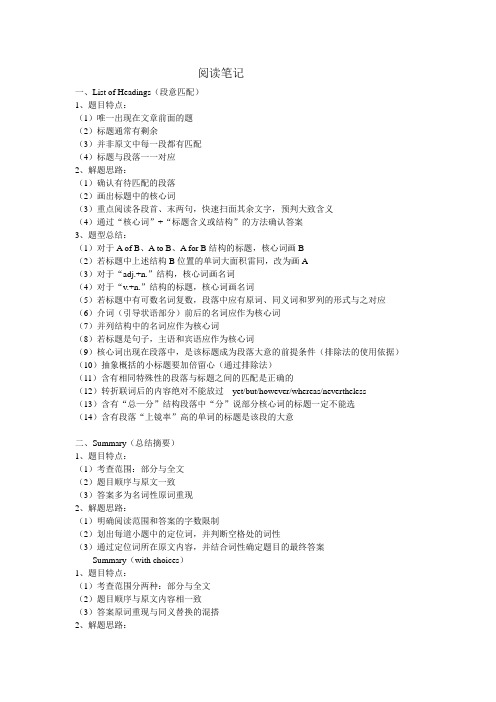
阅读笔记一、List of Headings(段意匹配)1、题目特点:(1)唯一出现在文章前面的题(2)标题通常有剩余(3)并非原文中每一段都有匹配(4)标题与段落一一对应2、解题思路:(1)确认有待匹配的段落(2)画出标题中的核心词(3)重点阅读各段首、末两句,快速扫面其余文字,预判大致含义(4)通过“核心词”+“标题含义或结构”的方法确认答案3、题型总结:(1)对于A of B、A to B、A for B结构的标题,核心词画B(2)若标题中上述结构B位置的单词大面积雷同,改为画A(3)对于“adj.+n.”结构,核心词画名词(4)对于“v.+n.”结构的标题,核心词画名词(5)若标题中有可数名词复数,段落中应有原词、同义词和罗列的形式与之对应(6)介词(引导状语部分)前后的名词应作为核心词(7)并列结构中的名词应作为核心词(8)若标题是句子,主语和宾语应作为核心词(9)核心词出现在段落中,是该标题成为段落大意的前提条件(排除法的使用依据)(10)抽象概括的小标题要加倍留心(通过排除法)(11)含有相同特殊性的段落与标题之间的匹配是正确的(12)转折联词后的内容绝对不能放过yet/but/however/whereas/nevertheless(13)含有“总—分”结构段落中“分”说部分核心词的标题一定不能选(14)含有段落“上镜率”高的单词的标题是该段的大意二、Summary(总结摘要)1、题目特点:(1)考查范围:部分与全文(2)题目顺序与原文一致(3)答案多为名词性原词重现2、解题思路:(1)明确阅读范围和答案的字数限制(2)划出每道小题中的定位词,并判断空格处的词性(3)通过定位词所在原文内容,并结合词性确定题目的最终答案Summary(with choices)1、题目特点:(1)考查范围分两种:部分与全文(2)题目顺序与原文内容相一致(3)答案原词重现与同义替换的混搭2、解题思路:(1)明确阅读范围和选项的使用次数(2)辨别选项词性,分析选项语义关系(3)画出每道小题的定位词,并结合选项判断空格处的词性(4)通过定位词在原文内容及选项,确定题目的最终答案3、题型总结:(1)在不超过数字限制的情况下,尽可能保留修饰、限定作用的成分(2)如果字数超限,从左向右依次删(3)对于空格处的词性判断要做到“瞻前顾后”(4)通过对生词词性及其在句中的成分的判断有助于最终答案的确定(5)对于题目内在逻辑关系的分析不仅可以更高效的划分定位词,还能更准确地把握答案的词性和词义(6)对于特征格外明显的题目可采用非常规的做题方法或答题顺序(7)对于答案范围不明显的题目可依据顺序原则:“掐头去尾”把控范围(8)a或the引导答案时,其本身就可以用于定位环节(9)注意选择类总结摘要题的干扰项形式,尤其注意近义词(10)确定选项可以被多次使用的唯一标识是“NB”三、Multiple Choice(选择题)1、题型特点:(1)考查类型:单选(细节与主旨题)和多选(细节)(2)题目顺序与原文内容相一致(主旨题不存在顺序问题)2、解题思路:(1)画出题目中的定位词(2)回原文查找有定位词出现的地方(3)边看该处文字,边看选项(4)选择与题意相符的最佳答案3、题型总结:(1)定位词有时可来自于选项(2)题意是判定选项“最佳性”的唯一标准(3)注意观察、分析选项间的异同性(4)细节、微观的选项是单选主旨题的常见干扰项四、Matching(搭配题)1、题型特点:(1)考查类型:人物类(说与做)和事物类(内容与属性)(2)选项可能会被多次使用(多次使用条件:题目个数大于选项个数、NB)(3)题目的本质是单选(4)题目不遵循顺序性原则2、解题思路:(1)明确选项的使用次数(2)选取并画出定位词(3)将原文扫读一遍,用不同的符号将各类定位词标注出来(4)仔细阅读每类定位词周围的文字,通过同义表述选出最终的答案3、题型总结:(1)通常情况下,在题目与选项两者间个数较少的一方划分定位词(2)如果出现有专业术语,应以其作为定位词(3)如果出现动宾结构,可通过谓语动词将题目或选项区分为“说”类和“做”类,使解题更具有针对性(4)人物类搭配题在原文中的呈现方式:full name, family name, 引号,代词(5)若定位词在原文中出现的次数差异明显,可按照“由少到多”的顺序来做题(6)通过题目或选项中熟识的单词即可完成排除法的使用五、TRUE/FALSE/NOT GIVEN(判断题)1、题型特点:(1)整体句义(2)顺序一致(3)细节微观2、解题思路:(1)画出题目中的定位词(2)依据定位词是否出现进行初步判断①若所有画的定位词都没出现,选NOT GIVEN②若有定位词出现,参看“解题步骤3”(3)依据定位词所在内容进行二次分析①原文中有对应信息,且文字内容方向一致甚至相同,选YES/TRUE②原文中有对应信息,但文字内容方向相反或矛盾,选NO/FALSE③原文中没有或有部分对应信息,选NOT GIVEN3、题型总结:(1)答案必须大写全拼,但要注意两种书写方式(2)是非的判断是建立在一件事的基础上(3)不同的两件事只能选NOT GIVEN(4)如果只有三道小题,通常会有一道NOT GIVEN (5)无论多少道小题,NOT GIVEN最多两道。
雅思阅读-list-of-heading
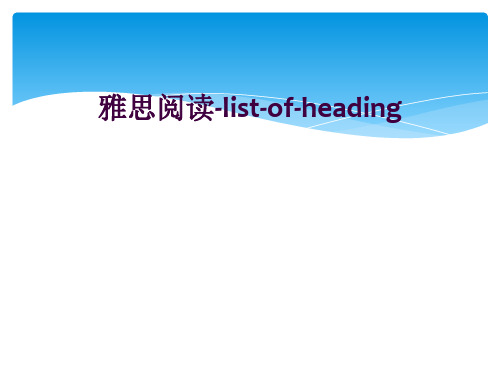
末句,5%左右在中间)
实例:主题句与支持句
In a growing number of hotels and skyscrapers across the nation, steel walls have replaced the foot-thick brick and mortar walls once used. Tests show that a steel wall four inches thick has better insulating qualities than a 12-inch thickness of masonry. In addition, steel-curtain wall panels save both time and labor. And the floor space conserved by use of the thin wall as against the thick wall in a big office building can mean a couple of hundred dollars a year in rentals.
Practice 1
Answer: iv
Answer: i
Answer: iii
Answer: v
Practice 2
Answer: iv
Answer: vi
Practice 3 - C7T2P3
Answer: vi
7 雅思基础阅读 List of heading
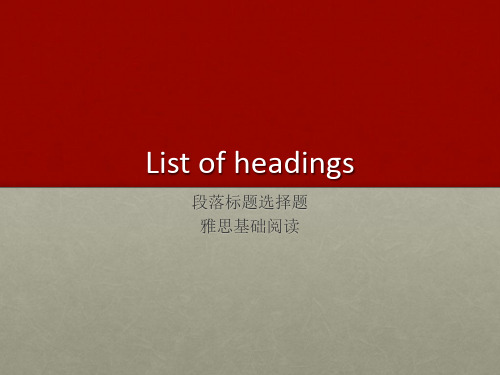
• C8 T1 P2 P22 C8 T2 P2 P45 C8 T2 P3 P49 C8 T3 P3 P74 C8 T4 P1 P88
• C9 T1 P2 P21 C9 T4 P3 P96
See you!
List of headings
段落标题选择题 雅思基础阅读
list of headings
段落标题选择题
段落标题选择题
1)题目位于文章 之前 2)选项以短语形 式出现,选项数量 多于段落数量,呈 乱序排列 3)选项不可能重 复使用
1)看文章标题
2)将例子所在的选项划去,同 时不用理会例子所在的段落
3)画出剩下选项的关键词
4)回归标题选项,再看一遍画 出的关键词,形成暂时记忆
5)略读文章的每一段话,寻找 主题句和核心词汇
6)某段话的答案确定后,将它 的选项从选项列表中划去
1)看文章标题
2)将例子所在的选项划去,同 时不用理会例子所在的段落
3)画出剩下选项的关键词
4)回归标题选项,再看一遍画 出的关键词,形成暂时记忆
3)画出剩下选项的关键词
4)回归标题选项,再看一遍画出的 关键词,形成暂时记忆
5)略读文章的每一段话,寻找主题 句和核心词汇
6)某段话的答案确定后,将它的选 项从选项列ist of headings) C4 T4 P3 P96
• C6 T1 P3 P26 C6 T2 P1 P40 C6 T3 P2 P67 C6 T4 P1 P85 C6 T4 P3 P93
5)略读文章的每一段话,寻找 主题句和核心词汇
6)某段话的答案确定后,将它 的选项从选项列表中划去
雅思阅读-小标题_list_of_heading

1) A steel wall has better insulating properties.
2) Steel wall panels save time and labor.
3) A steel wall conserves floor space.
Some Shortcuts
主题句一定是包含性最强的句子 1. 例句不是主题句 2. 问句不是主题句 3. 从句不是主题句 4. 明显包含细节的句子不是主题句 5. however 出现后看后半句 6. sb believe/hold/ imply 等引导的宾从是主句 7. In spite of/despite, 看后半句 8. 平行关系的段落没有主题句
LECTURE THREE 小标题
First things first
基础较好,List of heading 则一般先做 List of heading 题出现在文章前,要特
别注意不要漏做 在真实考试中,每个标题只用一次 例子中已经选过的段落可以直接去掉 注意不要写串答案
3 possibilities
Follow the following procedure
List of Headings The 1st, 2nd &
the Last Sentences Topic Sentence
Main Idea
Most suitable Heading
III 主题句与支持句练习
In a growing number of hotels and skyscrapers across the nation, steel walls have replaced the foot-thick brick and mortar walls once used. Tests show that a steel wall four inches thick has better insulating qualities than a 12-inch thickness of masonry. In addition, steel-curtain wall panels save both time and labor. And the floor space conserves red by use of the thin wall as against the thick wall in a big office building can mean a couple of hundred dollars a year in rentals.
- 1、下载文档前请自行甄别文档内容的完整性,平台不提供额外的编辑、内容补充、找答案等附加服务。
- 2、"仅部分预览"的文档,不可在线预览部分如存在完整性等问题,可反馈申请退款(可完整预览的文档不适用该条件!)。
- 3、如文档侵犯您的权益,请联系客服反馈,我们会尽快为您处理(人工客服工作时间:9:00-18:30)。
雅思阅读9分之List of Headings题在自己多年的教学过程中见过无数的考生因雅思阅读中一些复杂的题型而挣扎,其中有T/F/NG题,List of Headings题,和Which paragraph contains the following information题等等。
在这里我想首先传达一个信息—万事万物都有捷径,都有方法,关键在于寻找。
就像初中解答平面几何时,一些看似无解的题目往往会在一道,两道辅助线的作用下使自己豁然开朗。
同样,雅思阅读中这些所谓的难题其实并不难,关键在于掌握正确的思路、方法。
这里我要启发大家思考,传授一种解答雅思阅读中List of Headings题的“2.0版本”的解法。
List of Headings题也叫做小标题题,顾名思义就是为文章中每个段落选择合适的能够概括段落大意的小标题来。
这种题型在雅思阅读考试中经常出现。
然而这种题型却往往因为解题方法的错误被误认为是难题。
其实,只要掌握正确的解题方法,该种题型一定会变得很简单并且可以全部做对。
大多数考生认为这种题型较难,因为他们采用了如下错误的解题思路:第一,大多数考生解答这种题型的思路在于寻找段落的中心句或主题句。
第二,他们还认为段落的中心句或主题句通常段落的首句,次句或尾句。
第三,根据判断出来的中心句或主题句确定正确选项。
但是,雅思阅读所有文章都有主题句或中心句吗?就算有主题句或中心句,它一定出现在首句,次句或尾句吗?答案是否定的。
所以,使用这种方法,考生常常常会有这样的经验:看完一个段落的首句发现刚好有一个标题与这句话对应,于是就把它选出来,但是这个选项偏偏是错误选项。
这样一来,考生做10道题就经常会做错其中的5-6道,而通常去蒙的话,也基本上能对4-5道,所以这种做题方法非常不可取,因为一旦判断错误主题句就一定会选错答案。
这是第一代的做题方法。
那么,我们应该如何避免错误判定主题句、中心句的尴尬或者干脆直接跳过主题句或中心句的判断呢?关键在于看动脑筋,积极思考,寻找出路—答案就是List of Headings题“第二代”,“2.0版本”的解题方法。
第二代的做题方法采用了完全不同于第一代的解题思路。
因为我们知道,主题句一旦判定错误就肯定导致选择错误的选项,所以我们尝试避开判定主题句的障碍,转而寻找其他的解法。
利用主题句去判定段落标题的尝试是从文章到标题的过程,现在我们反其道而行之,采取从标题到文章的解题思路。
具体做法如下:第一步:阅读题目要求,把例题所选小标题从小标题列表中划掉。
(因为,一个段落所选标题其他段落是不会重复的)第二步:阅读所有小标题,判定反向思维词,并进行反向思维。
第三步:浏览段落。
第四步:比较段落与小标题,并利用排除法解答。
这里首先解释一下何谓“反向思维”和“反向思维词”。
“反向思维”是解答这种题型和解答雅思阅读难题—段落信息搭配题(which paragraph contains the following information)—的关键。
其实,大多数人对反向思维并不陌生,它就是大家中学期间都练习过的命题作文。
换句话说,反向思维就是把每一个小标题看成一个命题作文的标题,然后去想按照这个标题,这个段落会写什么样的内容,会出现什么词汇。
而“反向思维词”就是标题中能够提醒“反向思维”的词汇。
例如,如果现在有一篇文章,全文标题为《新航道记事》,按照反向思维该文章中一定会出现新航道,而且会围绕新航道而展开。
如果所有小标题中有一个选项为“我的雅思阅读老师王毅”,该标题中至少有两个反向思维词“雅思”和“王毅”,按照反向思维如果某个段落选择这个小标题,该段落一定至少会出现“雅思”和“王毅”这两个词。
如果这个段落没有这两个信息,那么该段落肯定不会选这个小标题,该小标题便可以排除。
采用这样“反向思维”的方法就可以巧妙的避开寻找主题句或中心句。
尽管文章看不太懂,但是每一个小标题每位考生都能读懂,并且可以进行反向思维。
这也就是我授课中经常提到的“如果英文不好就用中文来补足”。
然后,只需要简单的应用排除法便可以轻松把题目全部做对。
在看一些例题之前,我先总结一下小标题中常见的反向思维词。
1. 细节词。
如果某段落选择这个标题,该段落会出现这个细节词。
例如:The connection between health-care and other human rights中的human rights(剑四96页)2. 表达变化的词如:change, increase, growth, rise等。
如果某段落选择这个标题,该段落一般会出现数据。
例如:The impact of recent change中的change(剑四96页)3. future, past, recent这样表达时间的词。
如果某段落选择这个标题,该段落会出现日期,年代或时间。
例如:The impact of recent change中的recent(剑四96页)4. 复数(-s, -es)。
如果某段落选择这个标题,该段落会出现列举这个名词。
例如:The connection between health-care and other human rights中human rights的复数(剑四96页)5. 不定冠词a/an。
如果某段落选择这个标题,该段落会写到一个具体的案例。
例如:A successful exercise in people power中的a(剑六40页)6. some。
和a/an相似,如果某个段落选择这个标题,该段落会出现多个具体的案例。
例如Some poor selection decisions(例题)7. 表达流程的词汇process,procedure等。
如果某个段落选择这个标题,该段落会出现first, second, third这样的序数词或in the beginning, afterwards, finally等表达顺序关系的词汇。
(例题)8. first。
如果某段落选择这个标题,该段落会讲述该事物的诞生,一般会出现诞生的时间,地点或人物。
例如:The first rocket(剑三40页)9. development。
如果某段落选择这个标题,该段落会出现时间。
例如:The development of fire (剑三40页)当然除了以上列举的9种反向思维词外还有很多,这里就不在一一赘述。
下面便以一篇文章为例来讲解这种全新的第二代的做题方法。
文章及题目如下:READING PASSAGE 1You should spend about 20 minutes on Questions 1-5 which are based on Reading Passage 1.Questions 1-5Reading Passage 1 has seven paragraphs A-G.Choose the most suitable headings for paragraphs B-E and G from the list of headings below Write the appropriate numbers (i-x) in boxes 1-5 on your answer sheet.NB There are more headings than paragraphs so you will not use all of them.You may use any of the headings more than once.List of Headings(i) The effect of changing demographics on organisations(ii) Future changes in the European workforce(iii) The unstructured interview and its validity(iv) The person-skills match approach to selection(v) The implications of a poor person-environment fit(vi) Some poor selection decisions(vii) The validity of selection procedures(viii) The person-environment fit(ix) Past and future demographic changes in Europe(x) Adequate and inadequate explanations of organizational failureExample Paragraph A Answer (x)1. Paragraph B2. paragraph C3. Paragraph D4. Paragraph EExample Paragraph F Answer (ix)5. Paragraph GPEOPLE AND ORGANISA TIONS: THE SELECTION ISSUEA In 1991, according to the Department of Trade and Industry, a record 48,000 British companies went out of business. When businesses fail, the post-mortem analysis is traditionally undertaken by accountants and market strategists. Unarguably organizations do fail because of undercapitalisation, poor financial management, adverse market conditions etc. Yet, conversely, organizations with sound financial backing, good product ideas and market acumen often underperform and fail to meet shareholders’ expectations. The complexity, degree and sustainment of organizational performance requires an explanation which goes beyond the balance sheet and the“paper conversion”of financial inputs into profit making outputs. A more complete expla nation of “what went wrong”necessarily must consider the essence of what an organization actually is and that one of the financial inputs, the most important and often the most expensive, is people.B An organization is only as good as the people it employs. Selecting the right person for the job involves more than identifying the essential or desirable range of skills, educational andprofessional qualifications necessary to perform the job and then recruiting the candidate who is most likely to possess these skills or at least is perceived to have the ability and predisposition to acquire them. This is a purely person/skills match approach to selection.C Work invariably takes place in the presence and/or under the direction of others, in a particular or ganizational setting. The individual has to “fit”in with the work environment, with other employees, with the organizational climate, style of work, organization and culture of the organization. Different organizations have different cultures (Cartwright & Cooper, 1991; 1992). Working as an engineer at British Aerospace will not necessarily be a similar experience to working in the same capacity at GEC or Plessey.D Poor selection decisions are expensive. For example, the costs of training a policeman are about £20,000 (approx. US $30,000). The costs of employing an unsuitable technician on an oil rig or in a nuclear plant could, in an emergency, result in millions of pounds of damage or loss of life. The disharmony of a poor person-environment fit (PE-fit) is likely to result in low job satisfaction, lack of organizational commitment and employee stress, which affect organizational outcomes i.e. productivity, high labour turnover and absenteeism, and individual outcomes i.e. physical, psychological and mental well-being.E However, despite the importance of the recruitment decision and the range of sophisticated and more objective selection techniques available, including the use of psychometric tests, assessment centers etc., many organizations are still prepared to make this decision on the basis of a single 30 to 45 minute unstructured interview. Indeed, research has demonstrated that a selection decision is often made within the first four minutes of the interview. In the remaining time, the interviewer then attends exclusively to information that reinforces the initial“accept”or“reject” decision. Research into the validity of selection methods has consistently demonstrated that the unstructured interview, where the interviewer asks any questions he or she likes, is a poor predictor of future job performance and fares little better than more controversial methods like graphology and astrology. In times of high unemployment,! Recruitment becomes a“buyer’s market”and this was the case in Britain during the 1980s.F The future, we are told, is likely to be different. Detailed surveys of social and economic trends in the European Community show that Europe’s population is falling and getting older, The birth rate in the Community is now only three-quarters of the level needed to ensure replacement of the existing population. By the year 2020, it is predicted that more than one in four Europeans will be aged 60 or more and barely one in five will be under 20. In a five-year period between 1983 and 1988 the Commu nity’s female workforce grew by almost six million. As a result, 51% of all women aged 14 to 64 are now economically active in the labour market compared with 78% of men.G The changing demographics will not only affect selection ratios. They will also make it increasingly important for organizations wishing to maintain in their competitive edge to be more responsive and accommodating to the changing needs of their workforce if they are to retain and develop their human resources. More flexible working hours, the opportunity of work from homeof job share, the provision of childcare facilities etc., will play a major role in attracting and retaining staff in the future.首先按照我们做题的第一步,把例题段落A和F所选的x和ix选项从小标题列表中划掉,避免干扰我们。
